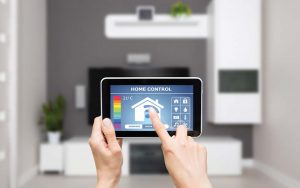Tired of ridiculous electricity bills? Concerned about the carbon footprints you might be leaving behind? Here are five tips to help you out!
Note: A solar energy craze swept over many countries at the turn of this century, and for a while, those nifty solar panels could be seen on almost every other rooftop! We can still spot them today, but they’re not s popular as they once were. In fact the trend took a downhill plunge at one time, flinging scores of the sector’s capitalists down in the dumps. (Scott, 2015). The then nascent green technology seemed to make a speedy comeback though, with the renewable energy sector flourishing once more. In the first quarter of 2015, S&P 500 (stock market index in the United States) witnessed scores of clean-tech companies outperforming other listed companies (Scott, 2015).
Would you invest in going green today?
It’s almost the rage now, even in the corporate world where ‘green buildings’ are the thing. Still, it won’t go very far without commitments at an individual level, be it at the office or even at home. If you’d like to jump in but have no clue where to start, read on…
Green investment used to be costly, but the cost has generally being driven down over the years thanks to research breakthroughs and the economies of scale which attends the burgeoning customer pool of green consumer goods. Unless of course, you intend to bringing home a Tesla roadster (an automotive brand producing battery-operated plugged-in electric cars) roadster, which costs around USD100,000 in the US (Truecar, n.d.)
The investments we present here though are far from costing you an arm and a leg. They could be easily implemented too.
1) Energy Efficient Light Bulbs
You might not think much of it, but switching to energy-efficient lights like light-emitting diode (LED) and compact fluorescent light bulb (CFL) is perhaps the most common and cheapest green move for the relatively minimal expenditure it requires. ‘Modern Thomas Edison’s bulb’ is an apt nickname for incandescent light for it operates on the same mechanism as the great 135-year-old invention (Elspeth, 2014). The emission of light is a product of heating the filament; the problem is that a chunk of heat is needed to generate a small amount of light, which is a massive waste of electricity (Howstuffworks, n.d.)
LED, on the other hand, directs a much higher percentage of the electrical power to generating light. Therefore, it is much more efficient in converting electricity to visible light than incandescent light bulb. A 10 watt (unit of measurement of energy consumption) LED bulb at IKEA that costs RM29.90 having a lifespan of 25,000 hours could deliver 600 lumen (unit of measurement of light output). It takes a 50 watt incandescent light bulb which could only last for 1,200 hours to match that performance (US Department of Energy, 2014).
In a nutshell, delivering the same performance, a LED bulb consumes up to 85% less energy and lasts 20 times longer than an incandescent light bulb (IKEA, n.d.). A LED bulb is certainly more expensive than an incandescent light bulb up front, but the invisible cost-saving effect attended by lower replacement rate (an incandescent light bulb would have been changed 20 times when a LED bulb finally burns out) and lower electricity bill certainly makes up for the additional upfront cost.
So, if your home is still lit with incandescent lights, it’s high time you made the change. For a cheaper option, choose a compact fluorescent light bulb (CFL) that comes with a price, performance level and energy consumption lying between those of LED and incandescent light bulb (Holly, 2015).
2) Electrical Goods With Higher Energy Efficiency Rating
Malaysia uses more electricity compared to its neighbouring countries. According to electricity consumption statistics compiled by The World Bank Group (n.d.), each Malaysian used an average of 4,313 kWh (kilowatt hours) of electricity in 2012, while the figures clocked by Thailand and Indonesia are 2,479 kWh and 733 kWh respectively. Energy Efficiency labelling scheme could be an alleviative tool in driving down that somewhat mortifying record. Energy Efficiency labelling scheme has been launched by Energy Commission of Malaysia mandates affixation of information of energy consumption on televisions, refrigerators, domestic fans and air-conditioners (Energy Commission of Malaysia, n.d.).
Based on the energy efficiency, these appliances are rated from two-star to five-star. Higher rating may be translated to higher price, but the yield could justify the additional cost. Pared down electricity bill could be expected with significantly less use of energy by energy-efficient appliances, compared to older appliances. For instance, replacing a conventional refrigerator with an energy-efficient model could bring us a slash of energy consumption by 40% (Meng, 2011).
Translating that to monetary terms, a five-star rated fridge substituting a 15-year-old model could mean RM40 reduction in monthly electricity bill (Meng, 2011). Be smart about it, though. Swapping a seven-year-old working dishwasher to a newer model does not bring about the same yield as replacing a 22-year-old refrigerator(Craig, n.d.) – the age and condition of the appliance you’re using now matters too.

3) Install A Programmable Thermostat
A programmable thermostat is an appliance helping us regulate the temperature of our home to a certain desired level at different times (with wake, leave, return, sleep settings) automatically. When setting the programme, we could lower the setting when we are at home, and raise it to a warmer temperature at night or when we are away from home. According to a study by Hiroshima University (Tetsu, Sangwoo, Doris & Dilshan, 2011) on energy consumption and air-conditioning usage in residential buildings of Malaysia, air-conditioning is ranked on top in terms of yearly electricity consumption, using up 1167 kWh of electricity, where else ceiling fans use just (670 kWh)!
Therefore, more efficient usage of air-conditioning could yield a significant reduction in our electricity bill. With the assistance of this technology, we could save ourselves the hassle of manually adjusting the temperature and remembering to switch off the air-conditioner when we leave home.
You can get this for about USD33 at ebay.com, with shipping fees and import charges included (eBay, n.d.). It helps keep the home at an ideal temperature while cutting down electricity cost and carbon footprint, all at an affordable price. That’s just what families and individuals want, that is, to save energy without compromising comfort.
4) Eat More Of The Green Stuff (And Cut Down The Meat)
Cutting down on meat in our diet is good way to relieve global warming. According to a report by United Nations Food and Agriculture Organization, livestock are accountable for 18% of greenhouse gas emission, in excess of all modes of transport combined (Food and Agriculture Organisation of the United Nations, 2006).
You don’t have to stop eating meat altogether, especially since meat is a good source of protein, vitamins and minerals that our body needs. Instead, just eat less. Cattle ranches, where beef cattle are bred, clear 28 times more land than other livestock and are turning a fifth of pastures and ranges into dessert (Geoffrey, 2006). Clearing land is hazardous to the environment as it wipes out vegetation – nature’s scavenger of carbon dioxide. Besides, it takes a cow a gigantic 990 litres of water to produce a litre of milk (Geoffrey, 2006). If this dietary tweak sounds convincing to you, you may want to know that replacing beef with other animal-based alternatives such as eggs could help you make an environmental contribution comparable to switching to plant food source (Matt, 2014).

5) Dusty air conditioners cost money!
Many make the mistake of disassociating air conditioners with dust, when the fact is, dust do collect on the blades. You should also expect a carpet of dust piling up on the filter of your air-conditioning unit if it wasn’t cleaned recently. This dust impedes airflow, forcing the machine to work harder, and use more power to carry out it’s duty of of keeping the air cool. Hence, cleaning your air conditioners every month can help save you money. (Energy Star, n.d.).You’ll really feel the difference, especially if you live in a dusty environment, such as a construction site, as most of household dust (around 60%) comes from outside (Jeffrey, 2010).
There you go! We hope these tips will prompt you to make some changes in your lives, but remember, it’s only through commitment and implementation can we actually make the difference, both for our planet and our finances as well.
Bibliography
Craig, G. (n.d.). Do energy-efficient appliances add up? Bankrate. Retrieve from http://www.bankrate.com/finance/personal-finance/do-energy-efficient-appliances-add-up-1.aspx
eBay. (n.d.). Honeywell Programmable Thermostat RTH2300B 5*2 Day Heat/Cool. Retrieved from http://www.ebay.com/itm/Honeywell-Programmable-Thermostat-RTH2300B-5-2-Day-Heat-Cool-/331601252633?hash=item4d34f99119
Elspeth, D. & ClimateWire. (2014, January 24). Goodbye and Good Riddance to Inefficient Incandescent Lightbulbs. Scientific American. Retrieved from http://www.scientificamerican.com/article/goodbye-and-good-riddance-to-inefficient-incandescent-lightbulbs/
Energy Commission. (n.d.). Guideline on Energy Efficiency Labelling for Electrical Appliances.Retrieved from http://www.st.gov.my/index.php/consumer/electricity/efficient-use-of-electricity/energy-efficient-appliances.html
Energy Star. (n.d.). Heat & Cool Efficiently. Retrieved from https://www.energystar.gov/index.cfm?c=heat_cool.pr_hvac
Food and Agriculture Organisation of the United Nations. (2006, November 29). Livestock a major threat to environment. Retrieved from http://www.fao.org/newsroom/en/news/2006/1000448/index.html
Geoffrey, L. (2006, December 10). Cow ’emissions’ more damaging to planet than CO2 from cars. The Independent. Retrieved from http://www.independent.co.uk/environment/climate-change/cow-emissions-more-damaging-to-planet-than-co2-from-cars-427843.html
Holly, J. (2015, April 29). Light Bulb Showdown: LED vs. CFL vs. Incandescent. The Simple Dollar. Retrieved from http://www.thesimpledollar.com/the-light-bulb-showdown-leds-vs-cfls-vs-incandescent-bulbs-whats-the-best-deal-now-and-in-the-future/
Howstuffworks. (n.d.). Are fluorescent bulbs really more efficient than normal light bulbs? Retrieved from http://home.howstuffworks.com/question236.htm
IKEA. (n.d.). LEDARE. Retrieved from http://www.ikea.com/my/en/catalog/products/10266221/
Jeffrey, K. (2010, February 23). What’s in Household Dust? Don’t Ask. Time. Retrieved from http://content.time.com/time/health/article/0,8599,1966870,00.html
Matt, M. (2014, July 21). Beef environment cost 10 times that of other livestock. BBC News. Retrieved from http://www.bbc.com/news/science-environment-28409704
Meng, Y. C. (2011, September 20). Conserve energy and reduce costs. The Star Online. Retrieved from http://www.thestar.com.my/story/?file=%2F2011%2F9%2F20%2Flifefocus%2F9075953&sec=lifefocus
Scott, N. (2015, June). Lower oil prices but more renewables: What’s going on? McKinsey & Company. Retrieved from http://www.mckinsey.com/insights/energy_resources_materials/lower_oil_prices_but_more_renewables_whats_going_on
Tetsu, K., Sangwoo, J., Doris, H. C. T., Dilshan R.O. (2011). Energy Consumption and Air-Conditioning Usage in Residential Buildings of Malaysia. Journal of International Development and Cooperation.17 (3), 61-69. Retrieved from http://ir.lib.hiroshima-u.ac.jp/files/public/32444/20141016190220391503/JIDC_17-3_61.pdf
The World Bank Group. (n.d.). Electric power consumption (kWh per capita). Retrieved from https://www.google.com/publicdata/explore?ds=d5bncppjof8f9_&met_y=eg_use_elec_kh_pc&idim=country:MYS:SGP:THA&hl=en&dl=en#!ctype=l&strail=false&bcs=d&nselm=h&met_y=eg_use_elec_kh_pc&scale_y=lin&ind_y=false&rdim=region&idim=country:MYS:SGP:THA:IDN&ifdim=region&tstart=49651200000&tend=1311955200000&hl=en_US&dl=en&ind=false
Truecar. (n.d.). Tesla History. Retrieved from https://www.truecar.com/prices-new/tesla/
US Department of Energy. (2014, July 28). Lumens and the Lighting Facts Label. Retrieved from http://energy.gov/energysaver/articles/lumens-and-lighting-facts-label


